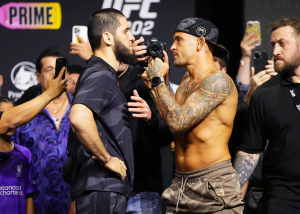Polishing the Skills: Mateusz Gamrot
Analyzing the Tactics and Techniques of Poland’s Double Champ
Poland’s Mateusz Gamrot burst into the collective consciousness of mainstream fight fans when his acquisition to the UFC was publicized in September, 2020. The then 29 year old Pole was immediately the center of much speculation and intrigue, having held two belts simultaneously in his native Poland’s KSW fight league. While KSW isn’t known for their elite level talent, it was clear that the four time ADCC European Trials medalist and former wrestling world team member was bona fide homegrown talent. Having bested former UFC staple Norman Parke twice to cement his championship talent, and proving his grappling acumen against the likes of perennial contender Garry Tonon at the ADCC Championships, Gamrot was certainly an anticipated signing and welcome newcomer.
Preceded by royal countrymen Jan Blachowicz and Joanna Jedrzejczyk, “Polish Power” was alive and well in the UFC’s highest echelons. However, Gamrot attempts to throw those comparisons on their heads, literally. With a strong cardio base, calculated pressure, and non-stop wrestling, Gamrot had earned himself a nearly flawless record; the only blemish coming by way of an accidental eyepoke No Contest. Riding raw athleticism and superb technical ability, Gamrot took the leap to polishing his game with the help of American Top Team tutelage, and no, that pun will not be apologized for. His UFC run thus far has been a wild ride, with bonuses in four of his five fights under MMA’s flagship banner, as well as a record setting submission. The Polish contender is set to face Beneil Dariush at the time of writing, and in preparation of the match-up, we’ll be attempting to examine some of the tools of the “Gamer’s” game and how they potentially line up against Dariush
.
Tools of the Trade:
A credentialed grappler, Gamrot stands apart from his championship compatriots, however his style in that specific avenue is unique in its own right. A lover of the ever rare low-single, Gamrot has built much of his game off that technique. While the low-single is an uncommon shot, Gamer has proven his adroitness and cunning with the options he builds into his offensive wrestling game. Typically entering from the Southpaw stance, leaning on a common habit of wrestlers to shoot off their right foot, Gamrot shoots his head off far past the elbow and ankle of his opponent’s right side, en route to snatching their lead leg by the ankle and calf. This defensive countermeasure not only swings his momentum into the shot, but it also protects him from knees like that which Damir Hadzovic used to delete Gamrot’s countryman Marcin Held on an ill-fated Imanari roll.
Unlike Held, however, Gamrot pushes his advantage as well as any can, opting to use a flow chart like array of positions and attacks off his ubiquitous low-single; going right into the crack down position, transitioning to the back when he knows an opponent will turn to their hands and knees, or riding their leg up into a treetop position to establish an opportunity for standing guard passes. It was this takedown that led to his record setting kimura against Jeremy Stephens in July of 2021. Against Stephens, Gamrot immediately fired out of the gate with a left overhand, occupying Stephens’ guard, while simultaneously throwing his weight over his lead leg and onto an easy level change. Stephens attempted to sprawl but Gamrot was quick to adapt, switching off to attempt the treetop when once again Stephens adjusted and started turning his trapped knee downwards. It was in this split-second game of “I go, you go” that Gamrot made his final adjustment and sucked Stephens’ leg inwards towards himself, creating a vacuum of space between them that Stephens’ posting leg could not sustain.
1)Gamrot’s initial low-single 2)Attempting to lift the leg 3)Finally, pulling away Stephens’ base
With his foe grounded and himself playing the top half guard position, Gamrot pushed his frenetic attack further. Stapling “Lil Heathen’s” bottom leg to the mat with his right knee and holding a bodylock, Gamrot invited his opponent to attack a kimura of his own, trapping Stephen’s hips meant he could not really threaten the kimura unless he found a way to escape Gamer’s staple. Flowing beautifully with the smallest movement of Stephens’ weight, Gamrot floated his way to the north-south position where he pinned Stephens’ upper body to the mat and isolated the arm in a matter of seconds. This sequence illustrates just how seamlessly Gamrot transitions from wrestling to grappling, the pivotal aspect of his style. However it was in Georgian export Guram Kutateladze and Armenian/Russian contender Arman Tsarukyan where Gamrot really had to dig deeper into his bag of tricks.
Seemingly allergic to taking easy fights, Gamrot made his UFC debut against fellow debutant, and largely unknown, Guram Kutateladze, the “Georgian Viking” out of Allstars MMA in Sweden. The fight went on to be Gamrot’s first, and only, professional loss to date. In what was an action packed scramblefest across three rounds, the pair cemented their inaugural UFC fight as an instant classic, as well as a glimpse into the depth of unranked lightweight ability. Both men showed tremendous adaptability as well as deeply honed skill sets. From the moment the fight began, Gamrot was entering behind feints and hand checking, clearing a path for his stiff left straight or distracting the probing hand from his takedown entries. With Guram utilizing his phenomenal kicking game, the Polish fighter relied on a wrestler’s oldest trick, level changes into punches, landing solid left hands and right hooks in combination in the fleeting moment Kutateladze’s hands dropped by the smallest margin. This multifaceted approach of feints, jabs, and handfighting plagued the decision making part of Kutateladze’s brain, overloading him with potential attacks and fatiguing his ability to read the Pole’s next move. This overworking of the mind afforded Gamrot his trademark low-single early in the fight. An intensely sophisticated scramble ensued therein; Gamrot was able to attempt his tripod passing while Guram framed and worked his way onto a kneebar attempt, an adept leglocker himself, Gamrot worked through the various positions before attempting a heelhook which forced Kutateladze to spin out and gift Gamrot the ability to get to his feet once again. Multiple times throughout the fight Gamrot would flow through his left straight into takedown entries, but the anti-wrestling of Kutateladze forced the fight to evolve further. As the shots became more obvious to the Georgian and the frames more reflexive, Gamrot anticipated the defense and used Kutateladze’s own reactions to drive himself into bodylocks and brief moments of wall work.
While the Kutateladze fight was a losing effort for the Polish fighter, both displayed moments of brilliance. Noticing that his patented takedown wasn’t working and his offensive pressure was walking him onto counters, Gamrot chose moments to yield the initiative. Giving Kutateladze opportunities to build and move forward, Gamrot played off of his reads. Finding moments where his opponent would blitz forward, often starting and ending combinations with low kicks, Gamrot made an expert adjustment in timing these kicks for easy takedowns where his typical attacks were unsuccessful.
1)Guram shows the blitz 2)Gamrot anticipates, changes level 3)Hands locked, base compromised 4)Reactive double
It was his fight against the much hyped super-prospect, Arman Tsarukyan, though, that really put Gamrot over. Tsarukyan, a high level grappler and stellar anti-wrestler in his own right, had the eyes of MMA fans all over the world firmly on him. The fight marked Gamrot’s (and Tsarukyan’s) first UFC main event, in a fight night banger. The wrestling exchanges throughout their clash were legendary, intense, and vastly impressive. Authors like the great Jack Slack have covered it in great detai,l in a piece on his Patreon this author highly recommends. Considering the coverage, I won’t dive too deeply into it, but you can see many of Gamrot’s abilities and adjustments on display throughout the fight, especially those which we have already touched upon. One would be remiss to not acknowledge that Gamrot had to fight for every success he found throughout the fight, tooth and nail. As the wrestling exchanges went longer, the more success he found, however. Tsarukyan managed to nullify many of the grappling engagements early in the fight, using his own incredible skill set; breaking grips, standing up immediately when taken down, and scrambling through positions when the traditional counter wrestling options weren’t available. For example, in the first round there was a fascinating back-and-forth wherein Tsarukyan shot a reactive double while Gamrot committed to strikes, Gamrot immediately caught an overhook and down-block, sprawling despite being dead to rights on the takedown. From there, Gamrot attempted a re-shot off the tie ups, ducking in on a fireman’s throw entry which likely would’ve switched off to a high crotch. However, Tsarukyan defended expertly as well, underhooking and catching a chin-strap en route to a front headlock, again though, Gamrot wouldn’t concede the position, posting off the mat and building his base he worked forwards and attacked an ankle pick which flowed right into his low-single. See below:
- Tsarukyan’s reactionary shot 2) Gamrot’s overhook and sprawl
3) Gamrot’s re-shot 4) Tsarukyan’s front headlock position
5) Gamrot’s ankle-pick off the front headlock 6) Back to his wheelhouse, lifting the leg
While Gamrot’s grappling style can be condensed into a word, tenacious; his striking often goes unheralded. Obviously, the gameplan stays consistent: get his man to the ground and get to work. However this is high level mixed martial arts in a historically talent rich division, it’s not that simple. Faced with opposition well versed in wall-walking, scrambling, and defensive grappling geared towards getting up, one typically can’t plan to get their man down and effectively keep them down across 15 minutes. That intermediary phase, between taking foes down and their efforts to return to the feet, is where Gamrot’s often overlooked striking proves itself.
Facing well equipped combatants, a fighter is forced to rely on strategic adjustments, whether minor or massive. When fighting Gamrot, one would imagine the impetus of training camp is particularly focused on stopping the shots. It’s this proclivity to stuff his offense that Gamrot is able to exploit and adjust his own game. This, of course, takes the form of striking. Belied by a stylistic “jank” of sorts, “Gamer” possesses a solid fundamental striking base that serves him well. Often using the threat of the takedown to find lead hooks or looping overhand punches. Against Kutateladze, Gamrot was able to find a few textbook counters. Slipping away from offense, conjuring images of the low-single, and cracking check hooks or straight rear hands in the momentary lapse. It goes to say, however, that Gamrot is a creature of habit, the striking exchanges serve to set up the impending takedown, and in the event that the striking gap extends out of his reach, the takedowns become much more obvious, bordering on desperate. And in modern mixed martial arts, being stuck under a sprawling opponent is one of the last places a fighter wants to find themselves. Against Tsarukyan, in the early going, Gamrot found himself on the wrong end of a speed advantage; rendering striking exchanges especially dangerous and prompting ill-advised, and often poorly timed shots. Tsarukyan, a notably technical wrestler in his own right, had little to no issue stuffing these shots. Opting to sprawl when needed and wrap up his preferred front headlock, Gamrot, to his credit, displayed a fantastic sit-out escape with frenetic scrambles ensuing. This combination of dogged wrestling offense, relentless defensive scrambling, and prudent striking makes the matchup with surging contender, Dariush, all the more exciting.
The Matchup: Dariush vs Gamrot
In the Iranian born Beneil Dariush, Gamrot has a chance at the next shot at the title that’s up for grabs in UFC 280’s main event, October 22nd in Abu Dhabi. Dariush, a multiple time world champion in jiujitsu, at the purple and brown belt levels, presents quite the challenge for Gamrot. Brought up under the tutelage of Rafael Cordeiro at Kings MMA, Dariush has evolved into a well rounded mixed martial artist. Theirs is likely to be a grappling heavy fight, where Gamrot’s offensive wrestling could potentially prove an ancillary function to Dariush’s own grappling.
Against an adept back-taker like Dariush, Gamrot cannot afford to find himself in the front headlock positions he shot into against Kutateladze or Tsarukyan. Off of similar stuffed shots, jiujiteiros have wreaked fight ending consequences in short order. Noting Gamrot’s defensive grappling capabilities, it’s fair to assume he can defend submissions at a high level. Regardless, having a high level grappler like Dariush clamped to his back for any significant length of time could very well steal the fight for the Iranian American. With that being said, should Gamrot use his intellectual takedown offense strategically and avoid any traps that await him, his offensive pace and grinding style could equally spell an exhaustive end for Dariush. In the striking realm, Dariush has looked more comfortable in the past, and exhibited a slight edge in power of late. However, Dariush’s at-time plodding footwork and apparent athletic deficit might hinder his striking opportunities against the younger, faster Pole. While I can’t definitively state what will happen, or even warrant much more than the opinions presented herein, I can assure the fight will feature a high level of grappling acumen on both sides and a more than likely feverish pace across a potential three rounds. With title implications on the line, I expect intensity from both and a potential breakout performance on a card already stacked with superstars.



